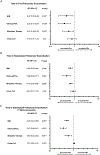Quantifying variation in home spirometry in people with cystic fibrosis during baseline health, and associations with clinical outcomes
- PMID: 37244842
- PMCID: PMC10674030
- DOI: 10.1016/j.jcf.2023.05.011
Quantifying variation in home spirometry in people with cystic fibrosis during baseline health, and associations with clinical outcomes
Abstract
Background: Home spirometry is increasingly used to monitor lung function in people with cystic fibrosis (pwCF). Although decreases in lung function in the setting of increased respiratory symptoms are consistent with a pulmonary exacerbation (PEx), the interpretation of home spirometry during asymptomatic periods of baseline health is unclear. The aims of this study were to determine the variation in home spirometry in pwCF during asymptomatic periods of baseline health and to identify associations between this variation and PEx.
Methods: Near-daily home spirometry measurements were obtained from a cohort of pwCF enrolled in a long-term study of the airway microbiome. Associations between the degree of variation in home spirometry and the time to next PEx were evaluated.
Results: Thirteen subjects (mean age of 29 years and mean percent predicted forced expiratory volume in one second [ppFEV1] of 60) provided a median of 204 spirometry readings taken during 40 periods of baseline health. The mean week-to-week within-subject level of variation in ppFEV1 was 15.2 ± 6.2%. The degree of variation in ppFEV1 during baseline health was not associated with time to PEx.
Conclusions: Variation in ppFEV1 measured with near-daily home spirometry in pwCF during periods of baseline health exceeded the variation in ppFEV1 expected in clinic spirometry (based on ATS guidelines). The degree of variation in ppFEV1 during baseline health was not associated with time to PEx. These data are relevant for guiding interpretation of home spirometry.
Keywords: Baseline health; Cystic fibrosis; Exacerbation; Home spirometry; Lung function.
Copyright © 2023 European Cystic Fibrosis Society. Published by Elsevier B.V. All rights reserved.
Conflict of interest statement
Declaration of Competing Interest There are no conflicts of interests for any authors in regard to this study.
Figures



References
-
- Graham BL, Steenbruggen I, Miller MR, Barjaktarevic IZ, Cooper BG, Hall GL, et al. Standardization of spirometry 2019 update. An official American Thoracic Society and European Respiratory Society technical statement. Am J Respir Crit Care Med. 2019;200(8):e70–e88; doi: 10.1164/rccm.201908-1590ST. - DOI - PMC - PubMed
MeSH terms
Grants and funding
LinkOut - more resources
Full Text Sources
Medical

